
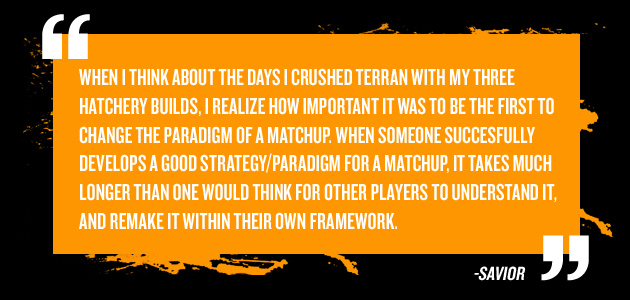
Introduction: How to Change History.
The last balance patch for StarCraft Brood War was in 2001, briefly after the dawn of professional Brood War. Since then, balance has remained entirely in the hands of players and mapmakers. Accidentally or not, Brood War was designed with such depth that even over a decade later, the game is as close to balanced as one can feasibly expect, despite many major evolutions and revolutions.
Players have defined the game's balance by inventing new strategies, reinterpreting units, and improving their overall understanding of their races. However, despite the fact that hundreds, if not thousands, of people have been playing professionally or competitively since 2001, the influence of the average player upon strategy, and thus balance, has been almost nonexistent. The enormous complexity of Brood War completely prevented players outside of the top-tier from creating effective builds or ideas. Even among professional Koreans, only a handful of players from each race have actually contributed. Therefore, for the most part, in the past decade only a select few individuals have been influencing game balance via strategic innovation. Racial balance has not been formed by unit stats or attributes, but through the race containing the most geniuses.
Without question, that race has been Terran. Boxer, Nada, Flash, and most of all, iloveoov, have been crucial in making Terran the most successful race in Brood War history. Other players, such as Midas, Sync, Xellos, Upmagic, and Fantasy, have also provided some useful ideas. Still, for the most part, Terran success has been carried on the shoulders of their four bonjwas. The sheer rate and complexity of their creations have kept Terrans in the driver’s seat for most of the past decade. Just when Protoss or Zerg players figured out a way to stop one Terran build, a completely new one would rise to replace the solved one and present a new problem.
Protoss has also relied mostly upon the efforts of four players to stay afloat. Reach, Nal_rA, Stork, and Bisu have all contributed crucial ideas and plans. Concepts such as anti-vulture pylon walls in PvT may seem commonplace and obvious now, but these concepts were revolutionary half a decade ago when Reach first introduced them. In one notable example, rA and Reach popularized Forge Nexus builds in PvZ. Bisu then took this opening to the next level by introducing a fast corsair, granting Protoss flexibility and reliable information while keeping Zerg guessing.
Yet competitive Zerg players, much like the in-game race itself, are different. They relied on one player to stand out above the rest, and keep a struggling Zerg race competitive in professional Brood War. Others have made some contributions, yes, but overall those contributions were minor in comparison. Savior completely transformed the basic identity of the Zerg race, and thus single-handedly altered the balance of Brood War.
Here's another way of looking at it: back in 2004, July and YellOw, the two best Zerg up to that point, felt strongly enough to publicly speak out on the perceived racial balance and suggest that ZvT needed Blizzard intervention. I bet any SC2 fans reading this are nodding their heads and thinking "this sounds awfully familiar." Yet seven years later, with no balance changes having been made, a similar statement from a top Zerg would incite howls of laughter.
The last balance patch for StarCraft Brood War was in 2001, briefly after the dawn of professional Brood War. Since then, balance has remained entirely in the hands of players and mapmakers. Accidentally or not, Brood War was designed with such depth that even over a decade later, the game is as close to balanced as one can feasibly expect, despite many major evolutions and revolutions.
Players have defined the game's balance by inventing new strategies, reinterpreting units, and improving their overall understanding of their races. However, despite the fact that hundreds, if not thousands, of people have been playing professionally or competitively since 2001, the influence of the average player upon strategy, and thus balance, has been almost nonexistent. The enormous complexity of Brood War completely prevented players outside of the top-tier from creating effective builds or ideas. Even among professional Koreans, only a handful of players from each race have actually contributed. Therefore, for the most part, in the past decade only a select few individuals have been influencing game balance via strategic innovation. Racial balance has not been formed by unit stats or attributes, but through the race containing the most geniuses.
Without question, that race has been Terran. Boxer, Nada, Flash, and most of all, iloveoov, have been crucial in making Terran the most successful race in Brood War history. Other players, such as Midas, Sync, Xellos, Upmagic, and Fantasy, have also provided some useful ideas. Still, for the most part, Terran success has been carried on the shoulders of their four bonjwas. The sheer rate and complexity of their creations have kept Terrans in the driver’s seat for most of the past decade. Just when Protoss or Zerg players figured out a way to stop one Terran build, a completely new one would rise to replace the solved one and present a new problem.
Protoss has also relied mostly upon the efforts of four players to stay afloat. Reach, Nal_rA, Stork, and Bisu have all contributed crucial ideas and plans. Concepts such as anti-vulture pylon walls in PvT may seem commonplace and obvious now, but these concepts were revolutionary half a decade ago when Reach first introduced them. In one notable example, rA and Reach popularized Forge Nexus builds in PvZ. Bisu then took this opening to the next level by introducing a fast corsair, granting Protoss flexibility and reliable information while keeping Zerg guessing.
Yet competitive Zerg players, much like the in-game race itself, are different. They relied on one player to stand out above the rest, and keep a struggling Zerg race competitive in professional Brood War. Others have made some contributions, yes, but overall those contributions were minor in comparison. Savior completely transformed the basic identity of the Zerg race, and thus single-handedly altered the balance of Brood War.
Here's another way of looking at it: back in 2004, July and YellOw, the two best Zerg up to that point, felt strongly enough to publicly speak out on the perceived racial balance and suggest that ZvT needed Blizzard intervention. I bet any SC2 fans reading this are nodding their heads and thinking "this sounds awfully familiar." Yet seven years later, with no balance changes having been made, a similar statement from a top Zerg would incite howls of laughter.
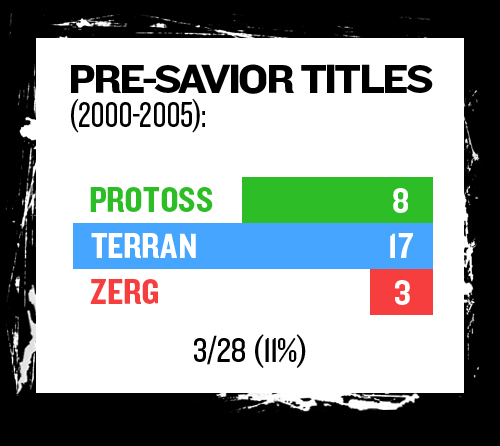
On its own, that statistic is bad enough. However, in reality it is much, much worse. One would think that more professionals playing one race would make for a greater likelihood of finding talented players among that race, right? Thus, all else being equal, the most popular races should do the best.

From inception to 2005, Zerg was the most popular progamer race by far yet still the worst.
So then, what happened post-Savior?
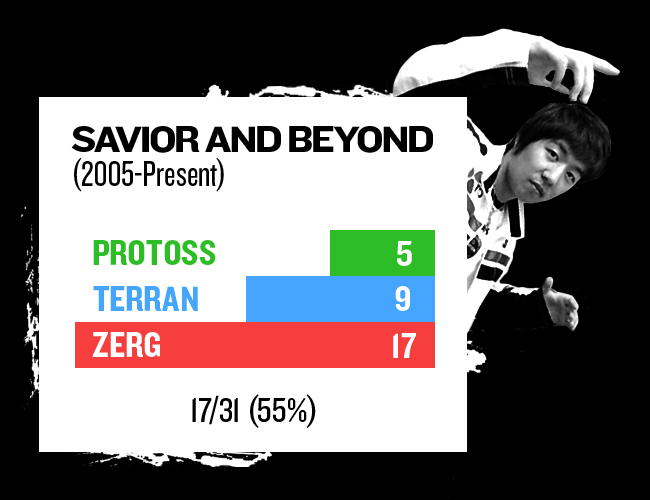
11% of titles versus 53%. An almost incomprehensible shift, and all due to one man Savior.
Savior is the most influential player on the balance of the game by far, and the statistics show it. He was the key that unlocked the overall understanding and theory of Zerg. Once that door was opened, suddenly Zerg users could understand their race and build upon Savior's innovations. But what was that key? Savior's main innovation was the flowing 3 hatch muta -> expand and drone -> lurker -> defiler -> expand -> 4 gas ultra/ling/defiler. But the recipe for Zerg success isn't that simple. Savior didn't just invent a build or two: he invented a totally new way to play a race.
Up until Savior, gamers playing Zerg approached the StarCraft much like the other races did. Zerg players would spend minerals and gas to create an army, then use that army to either attack the opponent or defend themselves while upgrading their economy with additional drones and hatcheries. This approach worked reasonably well in ZvP, but in ZvT it encountered great difficulty. Terran timings were too sharp, their units too cost-efficient, and their mechanics simply unstoppable at times. This intuitive plan to make "focus on economy" and "focus on army" two distinct modes fit well for other races, but it just wasn’t quite enough for Zerg. Lurker/ling or hydra/lurker armies were powerful but even if the Zerg won a battle or two, oftentimes the Terran would win in the end because the Zerg economy simply couldn’t keep up. The inability to produce a large army and drones at the same time prevented Zerg play from being like the other races.
In addition, Zerg armies cannot match Terran armies in terms of raw cost-efficiency. Players such as YellOw and July achieved some level of success with very aggressive, often all-in builds that relied on timing and micro, but as Terrans covered holes in their builds and defense, those aggressive Zerg fell behind and never came back. GoRush briefly eclipsed all competition using an early version of Savior’s build, but in the end he couldn’t maintain his form for long enough to have a serious impact.
In ZvT, the most common Zerg openings up until Savior were with lurkers, usually from 2 hatcheries. Many players made large numbers of zerglings early game to threaten the Terran or to keep themselves safe. Mutalisks were frequently used but they were often delayed. Zerg usually only felt safe getting mutalisks after first obtaining lurkers. Furthermore, mutalisks were used with the mindset of doing damage at all costs. This led to players producing too many mutalisks, and they ended up behind if they couldn’t hurt the Terran enough.
One of the best examples of the pre-Savior mid-lategame that relied upon large, mineral heavy armies is the famous comeback 0-2 to 3-2 OSL semifinal comeback of NaDa against GoRush. GoRush achieved a great lead with his initial armies and won several battles, but as the game lengthened, he began to lose control. GoRush kept banking on winning with each attack, but as Nada tenaciously held on time after time, GoRush didn't know how to transition or improve his position and eventually lost.
Savior saw far before anyone else that it just wasn't worth attempting to improve on the insufficient contemporary paradigm. He discarded all of these ideas and created an entirely new philosophy. If Savior wanted to overcome the barriers his peers faced, he needed to create a flowing game plan that could continually adapt and transition into a superior and more cost efficient army.
Before proceeding, Savior’s main innovation, 3 hatch muta, should first be clarified. To put it simply, it was a series of calculated transitions. Savior's 3 hatch muta was the first build to effectively divide the game into a number of phases which begun and ended at specific timings: for example, the first lurkers hatching would signal the start of a new phase, as would the completion of consume research for defilers. During each phase there was a specific goal: for example, after mutas spawned, the goal was to threaten the Terran, do some damage, make drones, and buy time until lurkers were ready. In order, the phases went as following:
Up until Savior, gamers playing Zerg approached the StarCraft much like the other races did. Zerg players would spend minerals and gas to create an army, then use that army to either attack the opponent or defend themselves while upgrading their economy with additional drones and hatcheries. This approach worked reasonably well in ZvP, but in ZvT it encountered great difficulty. Terran timings were too sharp, their units too cost-efficient, and their mechanics simply unstoppable at times. This intuitive plan to make "focus on economy" and "focus on army" two distinct modes fit well for other races, but it just wasn’t quite enough for Zerg. Lurker/ling or hydra/lurker armies were powerful but even if the Zerg won a battle or two, oftentimes the Terran would win in the end because the Zerg economy simply couldn’t keep up. The inability to produce a large army and drones at the same time prevented Zerg play from being like the other races.
In addition, Zerg armies cannot match Terran armies in terms of raw cost-efficiency. Players such as YellOw and July achieved some level of success with very aggressive, often all-in builds that relied on timing and micro, but as Terrans covered holes in their builds and defense, those aggressive Zerg fell behind and never came back. GoRush briefly eclipsed all competition using an early version of Savior’s build, but in the end he couldn’t maintain his form for long enough to have a serious impact.
In ZvT, the most common Zerg openings up until Savior were with lurkers, usually from 2 hatcheries. Many players made large numbers of zerglings early game to threaten the Terran or to keep themselves safe. Mutalisks were frequently used but they were often delayed. Zerg usually only felt safe getting mutalisks after first obtaining lurkers. Furthermore, mutalisks were used with the mindset of doing damage at all costs. This led to players producing too many mutalisks, and they ended up behind if they couldn’t hurt the Terran enough.
One of the best examples of the pre-Savior mid-lategame that relied upon large, mineral heavy armies is the famous comeback 0-2 to 3-2 OSL semifinal comeback of NaDa against GoRush. GoRush achieved a great lead with his initial armies and won several battles, but as the game lengthened, he began to lose control. GoRush kept banking on winning with each attack, but as Nada tenaciously held on time after time, GoRush didn't know how to transition or improve his position and eventually lost.
Savior saw far before anyone else that it just wasn't worth attempting to improve on the insufficient contemporary paradigm. He discarded all of these ideas and created an entirely new philosophy. If Savior wanted to overcome the barriers his peers faced, he needed to create a flowing game plan that could continually adapt and transition into a superior and more cost efficient army.
Before proceeding, Savior’s main innovation, 3 hatch muta, should first be clarified. To put it simply, it was a series of calculated transitions. Savior's 3 hatch muta was the first build to effectively divide the game into a number of phases which begun and ended at specific timings: for example, the first lurkers hatching would signal the start of a new phase, as would the completion of consume research for defilers. During each phase there was a specific goal: for example, after mutas spawned, the goal was to threaten the Terran, do some damage, make drones, and buy time until lurkers were ready. In order, the phases went as following:
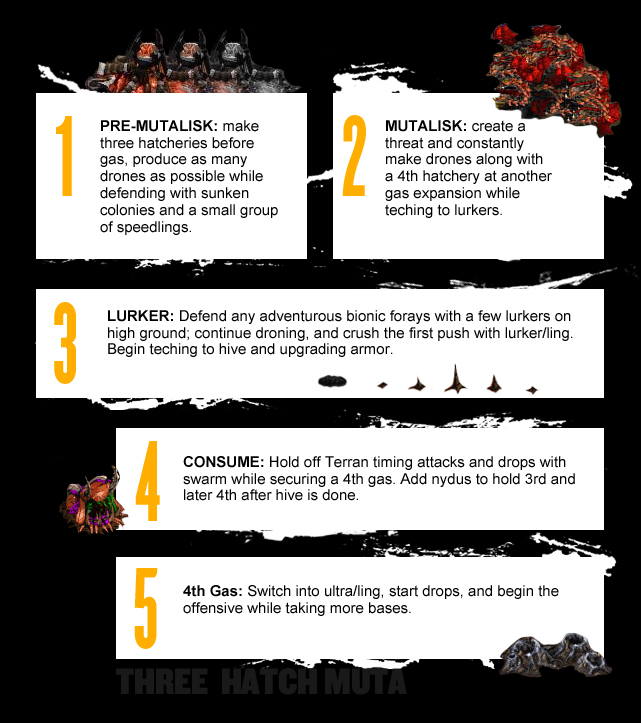
The New Standard: Three Hatchery Mutalisks.
Why was Savior's 3 hatch muta so dominant and long-lasting? To answer that, we must first understand how innovations generally work. The general pattern of innovations is that each one builds on the last, as if adding one more block to a tower. Here's a very brief, simplified history of mechanic Terran evolution in TvP as an example.
The first mech builds started were based around one base play, with players producing off two or even three factories from one base. Players like Boxer then realized that mech compositions were limited in small scale engagements, and opted instead for fast expansion builds off of one factory. These builds allowed Terran to safely establish a strong economic foundation, and then hit a troublesome mid game timing where Protoss had to carefully balance economy, tech, and army to hold off the attack. As Protoss players became more adept at this balancing act, Terran adapted by developing builds that took three bases quickly, and then hit a new mid-late game timing with a well upgraded mech composition while Protoss was still transitioning to their tier 3 tech. That leaves us roughly where we are today, with Terran's core TvP builds focusing on safely taking multiple expansions while gearing up for the late game. Every step of the way was a natural continuation from the previous phase, and that's how almost all other match-ups have progressed, with the exception of ZvT.
It took Savior some time to develop his ZvT style, quietly formulating throughout 2004 and early 2005. By mid-2006, after reacting to various Terran innovations, Savior created the version that we still see today. The key difference to Savior's strategic development of ZvT compared to other match-ups was that it rejected the existing paradigm entirely, and built a new framework from the ground up.
Semi-stacked mutalisk micro existed well before Savior rose to the top. 3 hatch muta existed for a long time before Savior rose to the top. Yet Savior's 3 hatch muta was completely different. Why? The answer lies in the intention of the build and the thought behind it. Before Savior, players generally did not feel comfortable going straight for mutalisks in safety. But Savior did not delay his mutalisks for lurkers; he went straight for them and relied on sunkens to keep himself safe. Not only did he take that supposed ‘risk,’ but he also double expanded immediately after his mutalisks hatched. However, that alone wasn't it. YellOw was doing 3 hatch muta into double expansion in 2002, yet he got nowhere with it. So what exactly was the difference?
In place of a hydra/ling heavy army with lurkers (quite a mineral heavy army) Savior divided his production into two areas: gas heavy mutalisks (100 minerals, 100 gas), then lurkers (125/125), while pouring all his excess minerals into drones. Instead of spending minerals on Zerglings or Hydralisks to secure a better economy, Savior spent all his gas and some minerals on mutalisks and lurkers to secure the economy, then used the majority of his minerals on making drones to upgrade his economy further. Mineral-efficient sunken colonies were used for early game defense instead of a hoard of zerglings. Only after he had maximized his income did Savior begin to make mineral units; by that point, his economy was already in overdrive.
Central to Savior's innovations were two core ideas. The primary one was that nine to eleven mutalisks can be used to secure a window where the Terran cannot move out and must play defensively against the mutalisks to avoid damage. Therefore, this period could be used to maximize drone production. The second idea was that two or three lurkers on top of a ramp could be used to completely defend an expansion at another main before the Terran got multiple vessels/irradiates. However, this defensive system was rigid and vulnerable after that window. In order to safeguard his expansions from drops and irradiates, Savior made sure he got hive quickly enough to get a nydus canal up in time to relocate his defenses to endangered bases.
In Savior's framework of the game, mutalisks were a faked threat. Their goal was simply to threaten, and appear menacing... and then make a plethora of drones behind it (of course, any damage that could be dealt against an unprepared opponent was a welcome bonus). This method was economically completely optimized against the standard 2 rax academy expand and 2 rax gasless expand builds of the time. They were rendered incapable of threatening Zerg and preventing him from droning, nor did they secure their own expansions fast enough to compete with Zerg's burgeoning economy.
Due to his superior understanding of the game, Savior realized that he could get away with expanding and droning right after mutalisks popped. His mutalisk flocks threatened grave damage to Terrans, forcing them to make turrets and stay in their bases. Savior's mutalisk micro may have been atrocious back then, but it didn't matter. Savior realized that he could use his mutalisks better by almost not using them at all. The mutalisks did more damage by simply flying around the Terran base and sniping a unit or two here and there than by actually going in and fighting head on. Savior's threat kept the Terran inside his base, afraid of any potential repercussions should he move out. And while the Terran was all huddled up, scared of what Savior might be doing, Savior was busy expanding and making only drones. Had Savior engaged more directly with his mutalisks like other Zerg before him, he might have done more damage but would lose mutalisks to attrition and thus remove the threat that the full-strength flock represented.
Savior used only 9-11 mutalisks because that was the magic number where the mutalisks became a serious threat that could not be ignored. More mutalisks would waste gas, and also minerals that could be used for drones, without creating a correspondingly greater threat.
Similarly, Savior only made a minimum number of lurkers to conserve resources. For mutalisks, their number was determined by the threat level Savior needed to present. As lurkers were used purely defensively, their quantity depended on what he needed to adequately defend his bases. He discovered that 2-3 lurkers on top of a ramp could effectively hold several dozen marines. Thus, instead of spending on a mobile army to defend his bases, Savior planted a few lurkers to hold the line. Savior’s usage of lurkers, as shown in the picture below, has vastly influenced how map designers create maps. He defined what was necessary for a decent Zerg map: third gas bases only accessible by a single ramp.
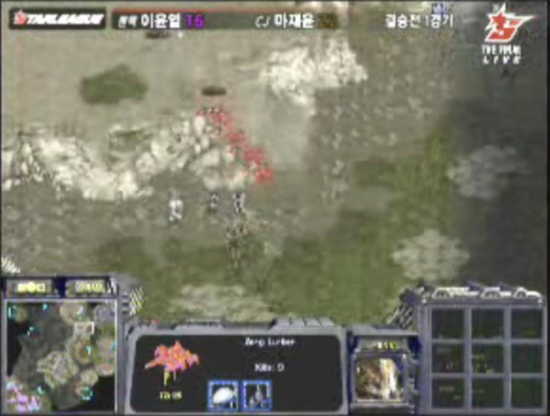
Yes, aggressive mutalisk micro would have eventually came along no matter what Savior did with the second discovery of magic box (no, not the one from StarCraft II) mutalisk stacking in 2006. But without Savior, there would be no economic mutalisk builds that worked solely on the threat of mutalisks. July could micromanage mutalisks rather well in 2004 but the way he reached that point is simply laughable with today's knowledge.
Just consider their different approaches: July's mutalisk micro was far better than Savior's, but July only felt safe after first securing his natural with lurkers even when on 2 hatcheries! Hence his mutalisks were considerably delayed, with so much map control and economy sacrificed to attain them that they became a pseudo all-in choice. Savior on the other hand could not do damage with mutalisks if the Terran built any kind of serious defense, but he didn't have to.
Without the tools and concepts Savior supplied, mutalisk stacking would have simply remained a flashy idea without teeth and a merely a viable way to all-in. It was only his ideas of economic management and the ability to produce mutalisks off of three hatcheries while making only drones that really unlocked Zerg. Savior's two versions of 3 hatch muta that took him to prominence were the first truly optimized and modern builds in StarCraft history, which are still used to this day.
A Lasting Difference.
Yet as brilliant as these ideas were, they was just not enough alone. Defiler based, gas-heavy Zerg armies lacked mobility and couldn’t keep up with the constant barrage of Terran threats. The Terran could force the Zerg to defend his natural, then immediately march over to the third base and crush it while the Zerg was effectively cut off. Savior solved this problem by making nydus canals a necessity instead of a cute trick. With the ability to teleport his army and shield any position on the map, Savior could project a previously inconceivable level of force on opposite ends of the map.
Yet Savior's 3 hatch muta is not just a bunch of small innovations thrown together haphazardly. If any piece of the puzzle didn’t exist, Savior's entire strategy would be void; the whole is clearly greater than the sum of its parts here.
Just consider this: Savior started doing the final form of 3 hatch muta -> lurker -> 3 gas defiler back in the beginning of 2006. Six years later, it was still somehow the most common ZvT strategy. Yes, 2 hatch muta had its heyday between late 2007 to early 2008 and 2009, 'Crazy Zerg' (a variation of Savior's build that discarded lurkers for very fast ultralisks) enjoyed some success in late 2007 and 2009, and 12 pool lair worked well in late 2009. But inevitably, those builds all went out of fashion or were relegated to being trick builds, while 3 hatch muta came back as the standard. I suspect that whether you read this now, or several years from now, Savior's three hatch mutas with his exact transitions and similar timings will still be the main ZvT opening. No other strategy in the game has remained the go-to choice remotely as long as his has.
Note that Savior applied a similar philosophy to ZvP as well. While this article series focuses solely on his ZvT, I just want to note that Savior’s new defensive, gas-focused concepts yielded an 80+% win ratio against the best Protoss players, leading to his ZvP being considered imbalanced for almost two years.
Now some may ask, what about Jaedong? Isn't a large part of modern Zerg dominance due to him? Isn't that earlier graph misleading? Yes, and no. First of all, Jaedong is a direct product of the Savior era. His initial rise to fame came from him understanding Savior's game plans in and out. While a fair share of his success was due to his sublime mutalisk micro and killer instinct with aggressive plays, many of Jaedong's best runs and wins came from Savior-inspired management. Without Savior's ideas, what Jaedong accomplished simply wasn't possible.
More importantly, in the post-Savior era Zerg users have the most even spread of titles by far. All Protoss titles since Savior really influenced the scene have came from Bisu (3), Stork (1), and now Jangbi (2). Terran titles came from Flash (6), Fantasy (1), ForGG (1), and Mind (1). Zerg titles came from Savior (4), Jaedong (5), Chojja (1), GGplay (1), Hydra (1), Effort (1), Calm (1), Luxury (1), GGplay (1), and July (1). Just in the same way as the ideas of Boxer, Nada, and iloveoov propelled a swarm of Terran into high placings back in the pre-Savior era, the direct legacy of Savior's ZvT is ten different Zerg title winners, when before him there were only two. Because of the sheer magnitude of this effect, Brood War history can effectively be divided into two eras, Pre-Savior and Post-Savior. Savior, while not the greatest innovator in sheer number of new creations, has influenced the course of Brood War strategy and balance more than any other.
Now that we understand three-hatch mutalisks—the basic framework Savior created for the Zerg race in ZvT—we can continue with the detailed analysis of Savior's tactics that began in God of the Battlefield: Part 1.
Why was Savior's 3 hatch muta so dominant and long-lasting? To answer that, we must first understand how innovations generally work. The general pattern of innovations is that each one builds on the last, as if adding one more block to a tower. Here's a very brief, simplified history of mechanic Terran evolution in TvP as an example.
The first mech builds started were based around one base play, with players producing off two or even three factories from one base. Players like Boxer then realized that mech compositions were limited in small scale engagements, and opted instead for fast expansion builds off of one factory. These builds allowed Terran to safely establish a strong economic foundation, and then hit a troublesome mid game timing where Protoss had to carefully balance economy, tech, and army to hold off the attack. As Protoss players became more adept at this balancing act, Terran adapted by developing builds that took three bases quickly, and then hit a new mid-late game timing with a well upgraded mech composition while Protoss was still transitioning to their tier 3 tech. That leaves us roughly where we are today, with Terran's core TvP builds focusing on safely taking multiple expansions while gearing up for the late game. Every step of the way was a natural continuation from the previous phase, and that's how almost all other match-ups have progressed, with the exception of ZvT.
It took Savior some time to develop his ZvT style, quietly formulating throughout 2004 and early 2005. By mid-2006, after reacting to various Terran innovations, Savior created the version that we still see today. The key difference to Savior's strategic development of ZvT compared to other match-ups was that it rejected the existing paradigm entirely, and built a new framework from the ground up.
Semi-stacked mutalisk micro existed well before Savior rose to the top. 3 hatch muta existed for a long time before Savior rose to the top. Yet Savior's 3 hatch muta was completely different. Why? The answer lies in the intention of the build and the thought behind it. Before Savior, players generally did not feel comfortable going straight for mutalisks in safety. But Savior did not delay his mutalisks for lurkers; he went straight for them and relied on sunkens to keep himself safe. Not only did he take that supposed ‘risk,’ but he also double expanded immediately after his mutalisks hatched. However, that alone wasn't it. YellOw was doing 3 hatch muta into double expansion in 2002, yet he got nowhere with it. So what exactly was the difference?
In place of a hydra/ling heavy army with lurkers (quite a mineral heavy army) Savior divided his production into two areas: gas heavy mutalisks (100 minerals, 100 gas), then lurkers (125/125), while pouring all his excess minerals into drones. Instead of spending minerals on Zerglings or Hydralisks to secure a better economy, Savior spent all his gas and some minerals on mutalisks and lurkers to secure the economy, then used the majority of his minerals on making drones to upgrade his economy further. Mineral-efficient sunken colonies were used for early game defense instead of a hoard of zerglings. Only after he had maximized his income did Savior begin to make mineral units; by that point, his economy was already in overdrive.
Central to Savior's innovations were two core ideas. The primary one was that nine to eleven mutalisks can be used to secure a window where the Terran cannot move out and must play defensively against the mutalisks to avoid damage. Therefore, this period could be used to maximize drone production. The second idea was that two or three lurkers on top of a ramp could be used to completely defend an expansion at another main before the Terran got multiple vessels/irradiates. However, this defensive system was rigid and vulnerable after that window. In order to safeguard his expansions from drops and irradiates, Savior made sure he got hive quickly enough to get a nydus canal up in time to relocate his defenses to endangered bases.
In Savior's framework of the game, mutalisks were a faked threat. Their goal was simply to threaten, and appear menacing... and then make a plethora of drones behind it (of course, any damage that could be dealt against an unprepared opponent was a welcome bonus). This method was economically completely optimized against the standard 2 rax academy expand and 2 rax gasless expand builds of the time. They were rendered incapable of threatening Zerg and preventing him from droning, nor did they secure their own expansions fast enough to compete with Zerg's burgeoning economy.
Due to his superior understanding of the game, Savior realized that he could get away with expanding and droning right after mutalisks popped. His mutalisk flocks threatened grave damage to Terrans, forcing them to make turrets and stay in their bases. Savior's mutalisk micro may have been atrocious back then, but it didn't matter. Savior realized that he could use his mutalisks better by almost not using them at all. The mutalisks did more damage by simply flying around the Terran base and sniping a unit or two here and there than by actually going in and fighting head on. Savior's threat kept the Terran inside his base, afraid of any potential repercussions should he move out. And while the Terran was all huddled up, scared of what Savior might be doing, Savior was busy expanding and making only drones. Had Savior engaged more directly with his mutalisks like other Zerg before him, he might have done more damage but would lose mutalisks to attrition and thus remove the threat that the full-strength flock represented.
Savior used only 9-11 mutalisks because that was the magic number where the mutalisks became a serious threat that could not be ignored. More mutalisks would waste gas, and also minerals that could be used for drones, without creating a correspondingly greater threat.
Similarly, Savior only made a minimum number of lurkers to conserve resources. For mutalisks, their number was determined by the threat level Savior needed to present. As lurkers were used purely defensively, their quantity depended on what he needed to adequately defend his bases. He discovered that 2-3 lurkers on top of a ramp could effectively hold several dozen marines. Thus, instead of spending on a mobile army to defend his bases, Savior planted a few lurkers to hold the line. Savior’s usage of lurkers, as shown in the picture below, has vastly influenced how map designers create maps. He defined what was necessary for a decent Zerg map: third gas bases only accessible by a single ramp.

These two lurkers prevent a large number of marines from coming near the expansion.
Yes, aggressive mutalisk micro would have eventually came along no matter what Savior did with the second discovery of magic box (no, not the one from StarCraft II) mutalisk stacking in 2006. But without Savior, there would be no economic mutalisk builds that worked solely on the threat of mutalisks. July could micromanage mutalisks rather well in 2004 but the way he reached that point is simply laughable with today's knowledge.
Just consider their different approaches: July's mutalisk micro was far better than Savior's, but July only felt safe after first securing his natural with lurkers even when on 2 hatcheries! Hence his mutalisks were considerably delayed, with so much map control and economy sacrificed to attain them that they became a pseudo all-in choice. Savior on the other hand could not do damage with mutalisks if the Terran built any kind of serious defense, but he didn't have to.
Without the tools and concepts Savior supplied, mutalisk stacking would have simply remained a flashy idea without teeth and a merely a viable way to all-in. It was only his ideas of economic management and the ability to produce mutalisks off of three hatcheries while making only drones that really unlocked Zerg. Savior's two versions of 3 hatch muta that took him to prominence were the first truly optimized and modern builds in StarCraft history, which are still used to this day.
A Lasting Difference.
Yet as brilliant as these ideas were, they was just not enough alone. Defiler based, gas-heavy Zerg armies lacked mobility and couldn’t keep up with the constant barrage of Terran threats. The Terran could force the Zerg to defend his natural, then immediately march over to the third base and crush it while the Zerg was effectively cut off. Savior solved this problem by making nydus canals a necessity instead of a cute trick. With the ability to teleport his army and shield any position on the map, Savior could project a previously inconceivable level of force on opposite ends of the map.
Yet Savior's 3 hatch muta is not just a bunch of small innovations thrown together haphazardly. If any piece of the puzzle didn’t exist, Savior's entire strategy would be void; the whole is clearly greater than the sum of its parts here.
Just consider this: Savior started doing the final form of 3 hatch muta -> lurker -> 3 gas defiler back in the beginning of 2006. Six years later, it was still somehow the most common ZvT strategy. Yes, 2 hatch muta had its heyday between late 2007 to early 2008 and 2009, 'Crazy Zerg' (a variation of Savior's build that discarded lurkers for very fast ultralisks) enjoyed some success in late 2007 and 2009, and 12 pool lair worked well in late 2009. But inevitably, those builds all went out of fashion or were relegated to being trick builds, while 3 hatch muta came back as the standard. I suspect that whether you read this now, or several years from now, Savior's three hatch mutas with his exact transitions and similar timings will still be the main ZvT opening. No other strategy in the game has remained the go-to choice remotely as long as his has.
Note that Savior applied a similar philosophy to ZvP as well. While this article series focuses solely on his ZvT, I just want to note that Savior’s new defensive, gas-focused concepts yielded an 80+% win ratio against the best Protoss players, leading to his ZvP being considered imbalanced for almost two years.
Now some may ask, what about Jaedong? Isn't a large part of modern Zerg dominance due to him? Isn't that earlier graph misleading? Yes, and no. First of all, Jaedong is a direct product of the Savior era. His initial rise to fame came from him understanding Savior's game plans in and out. While a fair share of his success was due to his sublime mutalisk micro and killer instinct with aggressive plays, many of Jaedong's best runs and wins came from Savior-inspired management. Without Savior's ideas, what Jaedong accomplished simply wasn't possible.
More importantly, in the post-Savior era Zerg users have the most even spread of titles by far. All Protoss titles since Savior really influenced the scene have came from Bisu (3), Stork (1), and now Jangbi (2). Terran titles came from Flash (6), Fantasy (1), ForGG (1), and Mind (1). Zerg titles came from Savior (4), Jaedong (5), Chojja (1), GGplay (1), Hydra (1), Effort (1), Calm (1), Luxury (1), GGplay (1), and July (1). Just in the same way as the ideas of Boxer, Nada, and iloveoov propelled a swarm of Terran into high placings back in the pre-Savior era, the direct legacy of Savior's ZvT is ten different Zerg title winners, when before him there were only two. Because of the sheer magnitude of this effect, Brood War history can effectively be divided into two eras, Pre-Savior and Post-Savior. Savior, while not the greatest innovator in sheer number of new creations, has influenced the course of Brood War strategy and balance more than any other.
Now that we understand three-hatch mutalisks—the basic framework Savior created for the Zerg race in ZvT—we can continue with the detailed analysis of Savior's tactics that began in God of the Battlefield: Part 1.

 Savior vs Hwasin on Longinus II.
Savior vs Hwasin on Longinus II.Perhaps the simplest form of ambushing is killing isolated forces. The most common time to do so is when a Terran is sending reinforcements to join a main army already settled in a strong position. The Terran usually does not want to surrender his position in order to link up with the reinforcements and thus leaves the reinforcements vulnerable out of necessity.
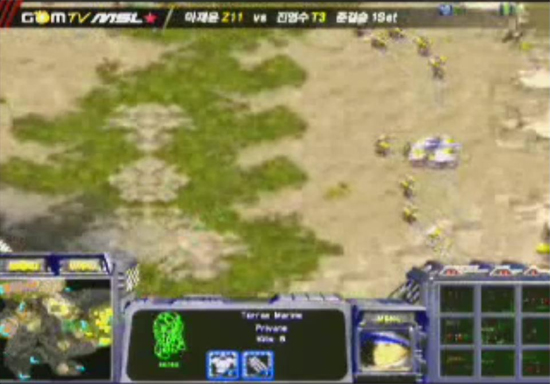
Hwasin moves to take the important ground outside of Savior’s natural.
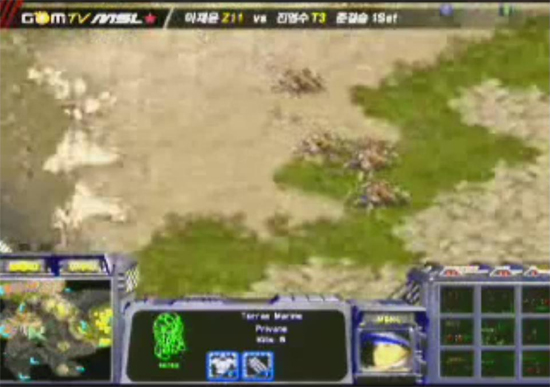
Meanwhile, Savior runs around behind him.
Savior’s maneuver around the side and behind Hwasin’s main army served three purposes. First, it kept Hwasin in the dark. A known location of enemy strength can be scanned and planned against. An unknown enemy hidden in the fog is a constant threat that makes it harder to plan siege timings and unit formations. Second, this maneuver put Savior in an excellent position to envelop Hwasin’s army at a moment's notice. Third, it could prevent any units from reinforcing Hwasin’s army and Hwasin would have little idea of the danger until it was too late.
The FPview is a really great tool for seeing the usefulness of ambushing stray groups like this (unfortunately, the video has been removed since the time of writing). Hwasin's POV shows that he only sees the immediate area around his army and base. The path his units must take, while straightforward, is prone to units appearing from any and all sides, or simply killing from below. At any point his units could be attacked and he would have no chance of saving them. In this instance he reacts reasonably quickly but there is nothing he can do.
The FPview is a really great tool for seeing the usefulness of ambushing stray groups like this (unfortunately, the video has been removed since the time of writing). Hwasin's POV shows that he only sees the immediate area around his army and base. The path his units must take, while straightforward, is prone to units appearing from any and all sides, or simply killing from below. At any point his units could be attacked and he would have no chance of saving them. In this instance he reacts reasonably quickly but there is nothing he can do.

Savior’s units surround and kill Hwasin’s paltry reinforcements before Hwasin can react.
Sending reinforcements without sufficient protection like Hwasin did was basically signing their death warrant against Savior, but Hwasin had little choice. At an earlier point in the game he hoarded units in his base for fear of a counterattack and Savior simply stalled, made more units, and killed his isolated army. Hwasin was cutting SCVs and was effectively all-in, needing to give his army the maximum amount of strength possible for one final push. If he took the safe approach and kept his small reinforcements at home until he could send a substantial group together, his main army would be isolated, dead, and the game would be over before they could arrive.
Killing these reinforcements was critical for Savior in winning the upcoming battle, as evidenced by how close the fight would end up being. Had Hwasin successfully been able to link both forces, the game might have remained an uncertain contest. As it was, Savior barely won the battle and thus easily took the game a minute later as Hwasin's all-in didn’t pay off.
Killing these reinforcements was critical for Savior in winning the upcoming battle, as evidenced by how close the fight would end up being. Had Hwasin successfully been able to link both forces, the game might have remained an uncertain contest. As it was, Savior barely won the battle and thus easily took the game a minute later as Hwasin's all-in didn’t pay off.


 Savior vs Nada on Arkanoid
Savior vs Nada on ArkanoidFlanking was not a tactic originally created by Savior. That said, he did standardize flanking. Before Savior, flanking was simply a luxury that was seen as a good idea but rarely done. After Savior began to flank for almost every single major engagement each game, others caught on.
At its core, flanking is a simple act of attacking a force from multiple directions. However, such a description belies the real difficulty in performing a good flank. Not only does the player have to time the attack just right, he also has to maneuver two or more armies entirely separately against one united, mobile army of the foe as well as switch screens in order to micromanage both in battle. In face of such difficulties most Zerg users avoided flanks like the plague and opted instead for head-on, one-dimensional attacks. However, Savior chose to take on difficult and dangerous moves like flanking, mastering them until they were no longer risky, but simply the only smart option to make.
Perhaps the most iconic example of a Savior flank comes from the final moments of his famous Superfight victory against NaDa on Arkanoid. For thirty minutes NaDa had hammered Savior’s forces with never-ending streams of marines and vessels while dropping expansions and preventing Savior from taking a 4th base. Savior tenaciously held on, counterattacked Nada, and finally managed to sneak a hidden 4th base and held onto it while NaDa slowly mined out. At the very end of the game, NaDa still had one last chance at being able to secure a new base by defeating Savior’s army with his still sizable forces. However, NaDa was outmaneuvered and crushed in a rare display of flashiness from the Maestro. Savior didn't even need defilers.
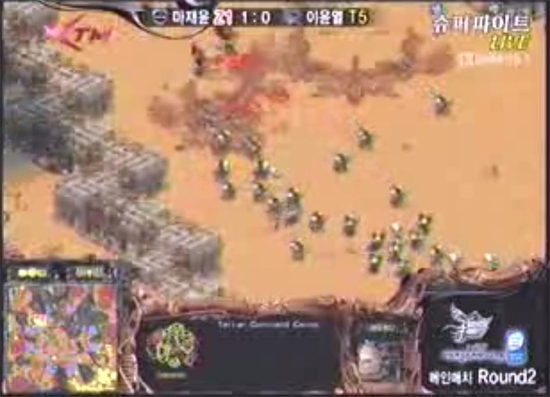
Nada attempts to clear out the upper left and secure a new expansion but is prevented by a fresh Zerg force.

Nada’s army can’t retreat into the middle either, becoming blockaded in the upper left choke.
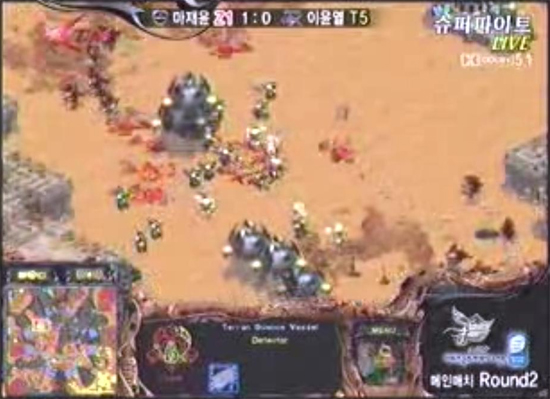
Hemmed in on both sides, the Terran army is shredded to pieces.


Savior v Nada on Rush Hour 2
One major problem Zerg users have is pursuing a wounded Terran army in order to maximize the advantage of a battlefield victory. Zerg users don't have any issues pushing Terran back with dark swarm, but short of ensnare, a far larger army, or favorable terrain, they simply can't pin a Terran army down. Savior was able to get around this problem by pushing the fleeing vagabonds into waiting lurkers.
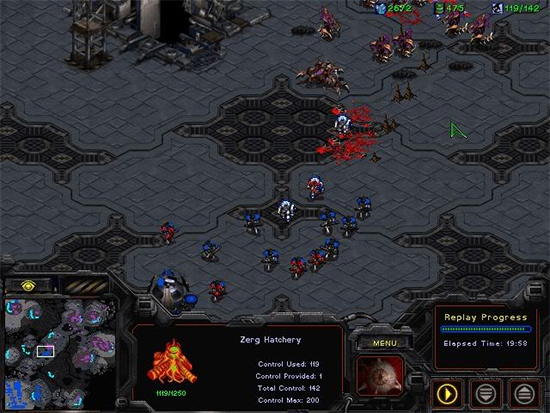
Savior drives Nada back with hydra/lurk.
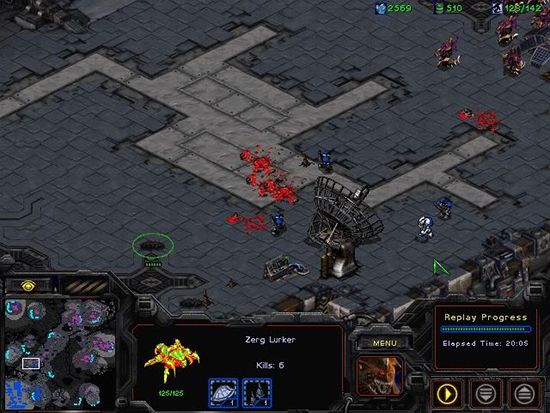
Savior ensures 100% casualties by blocking Nada's retreat.
By placing lurkers along the supply lines, Savior not only ensures Nada's army is not reinforced but also sets up an easy way to finish off wounded enemy units. In this example Nada was so worried about fleeing from Savior's army that he scarcely considered the possibility that lurkers might be blocking his retreat. The great part of this tactic is that it often can utilize lurkers already positioned to block reinforcements.

 Savior vs Yooi on Arcadia 2
Savior vs Yooi on Arcadia 2In a rather peculiar position, Yooi attempts a fast tank push but then sloppily loses his tanks to mutalisks. As a result, he is stuck with a toothless army that can only stand around and look menacing. However, Savior knows he can eventually build a large enough army to tear about his superficial force if he waits long enough, requiring a retreat sooner or later. From Yooi's point of view, he has contained Savior's army inside his base, so naturally he suspects nothing when he retreats from Savior's impending attack. All he needed to do was get home and regroup before Savior's army was large enough to surround his advance force. Thus, Yooi's attention was on protecting his rear, meaning his attention was diverted from the ambushing lurkers that Savior had morphed in the middle of the map as a reserve. These retreat-blocking lurkers quickly made mincemeat of Yooi's forces.
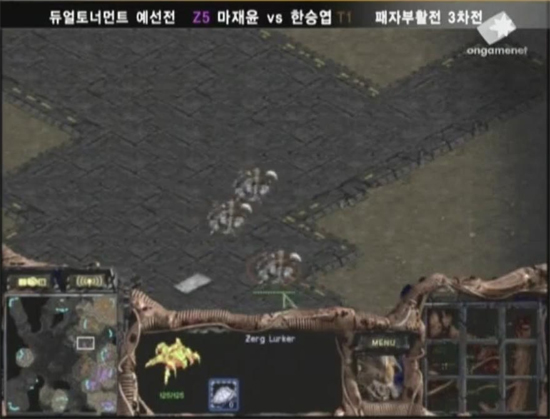
Savior positions hidden lurkers on Yooi’s retreat path.
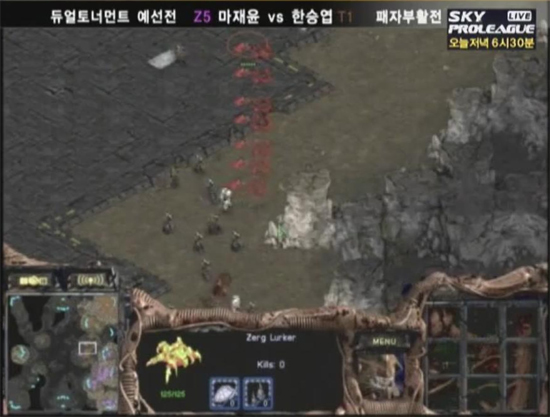
A third of Yooi's force is shredded by the lurkers.
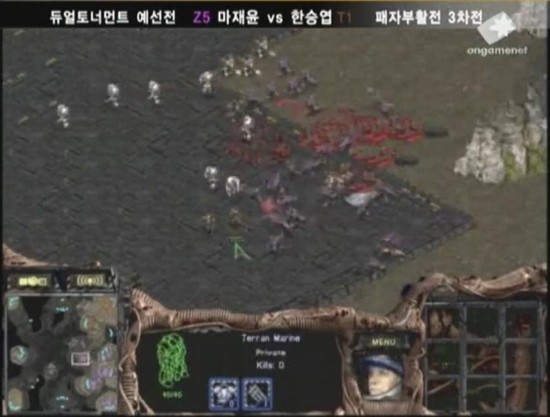
The lurkers then prevent Yooi's two armies from joining, thus enabling Savior's combined army to slaughter Yooi's isolated forces.
The lurkers here fulfilled two purposes. Naturally, they caught Yooi by surprise and munched on a row of marines. Just as importantly though, they acted as a barrier between Yooi’s now-depleted advance force and his reinforcements. Yooi had to spend several seconds regrouping his units and healing up from lurker damage, and in that period, Savior was able to chomp off Yooi’s remaining units before Yooi’s two armies could link up.

 Savior vs Hwasin on Longinus 2
Savior vs Hwasin on Longinus 2Oftentimes a certain step is needed to unlock the potential to create a tactic. In this game against Hwasin, Savior opened with a drone-heavy two hatchery lurker, against which the Terran can take an aggressive posture and shut down the third base. Savior was taking a grave risk, as he needed to hold his third base with a paltry force of zerglings. Because he made many drones, he did not have the zerglings to challenge Hwasin on the field in order to secure his third.
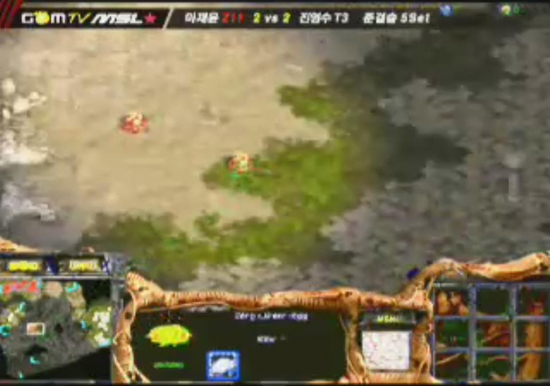
Savior hides two hydras and morphs them into lurkers in an inconspicuous location. Meanwhile Hwasin prevents a third base at the 9 o’clock expansion.
Had these lurkers not been safely made and hidden, the next parts would not be feasible. It was only because Savior planned well ahead that he had the chance to make this trap work.
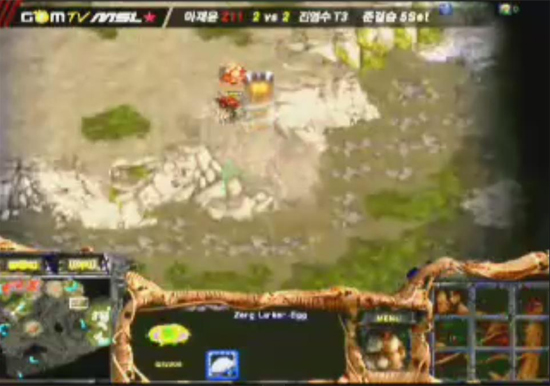
Hwasin scouts Savior’s new expansion and sees two lurkers morphing to defend it.
After Hwasin’s scv scouted Savior’s two lurkers morphing at the ramp, he knew that he could march up to at least the ramp of the third base before having to worry about any lurkers. Then he could scan ahead and plan his actions from there. However, his units never made it to the ramp. Savior’s two hidden lurkers were ready.
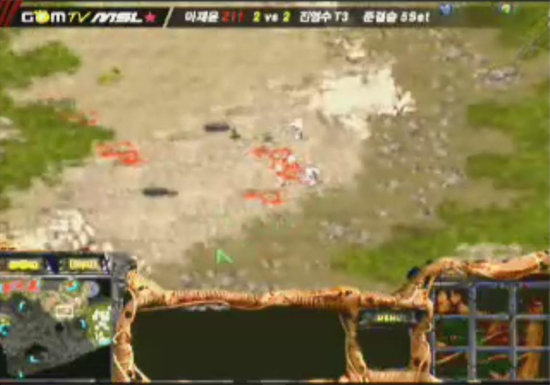
Hwasin’s marines are suddenly killed by unseen foes.
Hwasin was following the textbook and making all the correct steps. He was simply punished for scouting correctly and moving his forces in an intelligent manner. The only way he could have avoided the lurker ambush was to deliberately take an unnecessarily long march around the south side. However, had he done so he might have let his new army moving north towards the third become isolated (and killed) if Savior decided to make a play. As the game showed, Hwasin’s reinforcements were not enough to deal with Savior’s full army even with a superior position; Savior rescued his third and gained enough momentum to secure the win. With the knowledge Hwasin had, such a proposal would be nonsensical. Had Hwasin not seen any lurkers near the third, he would've had every reason to be suspicious of a trap. However, since Savior showed Hwasin the two morphing lurkers at the ramp Hwasin was lulled into a false sense of security.
The only other alternative for Hwasin would have been to keep his original bionic squad camped outside Savior’s natural while his reinforcements deny the third. However, this move is very risky as Hwasin doesn’t know Savior’s army strength and can’t afford to use scans to check his drone count. If Hwasin leaves his force outside Savior’s natural for more than another thirty seconds or even less, it simply becomes free pickings for Savior’s newly bolstered army. This would have been a better alternative than what happened in the game, but without a map hack such a choice would not be wise. Normally when a player is at a disadvantage it is their fault they are in that predicament. Here, Hwasin ended up behind because he played correctly.
The only other alternative for Hwasin would have been to keep his original bionic squad camped outside Savior’s natural while his reinforcements deny the third. However, this move is very risky as Hwasin doesn’t know Savior’s army strength and can’t afford to use scans to check his drone count. If Hwasin leaves his force outside Savior’s natural for more than another thirty seconds or even less, it simply becomes free pickings for Savior’s newly bolstered army. This would have been a better alternative than what happened in the game, but without a map hack such a choice would not be wise. Normally when a player is at a disadvantage it is their fault they are in that predicament. Here, Hwasin ended up behind because he played correctly.

 Savior vs iloveoov on Geometry
Savior vs iloveoov on GeometryIn a losing position, Savior needed to hinder iloveoov's economy to have some chance at hanging onto the game. With the so-called 'Cheater Terran' having two more bases than other players would, Savior had to do some major economic damage. Unfortunately, all he could spare was a handful of lurkers and zerglings.
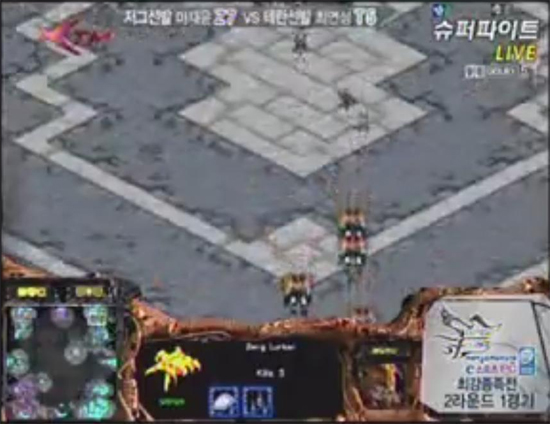
Savior runs lings into the expansion. The SCVs naturally scamper away, only taking a few casualties.
Savior’s lings run into the naked expansion but are able to do little damage at first as oov speedily runs marines over to rescue his base while pulling SCVs to safety. However, Savior planned for this eventuality and placed two lurkers at the exit to the base.

oov immediately rushes reinforcements to save his SCVs and retake the expansion. However, they are slaughtered by hungry lurkers waiting at the entrance.
oov reacts in time to save his SCVs from running into the lurkers, but with the lurkers barring the path of any reinforcements, he can do nothing but watch his SCVs die helplessly to the few unrestricted zerglings. Savior is able to kill all but three SCVs before oov can dispatch several tanks to eradicate the pests. For two lurkers and half a dozen lings, Savior netted over a dozen SCV kills, disrupted mining time, and obliterated half a dozen marines in addition to forcing oov to expend extra attention on relocating tanks and vessels. oov seemed to have been aware of the lurkers, but faced with the simultaneous necessity of microing his marines and moving his SCVs, he was not able to save his marines from unnecessary deaths.

A notable aspect of Savior's ambushing is just how many ways he thought of to get the Terran to walk blindly into lurkers.
Early on Savior's tactics were basic and limited. Even though they worked, Terran users quickly caught on and Savior was forced to improvise. Earlier moves that might have decimated an entire army were suddenly avoided or neutralized at low costs. Placing lurkers on the Terran's supply lines now became just a way to slow reinforcements and force extra attention and scans, not a way to get free kills. However, once Savior understood how to induce his foes into ambushes, he came into possession of a versatile weapon that worked again and again without failure. Even Iris, a teammate who clearly was so familiar to Savior's tricky dealings, was still vulnerable to this type of psychological ploy.
 Savior vs Iris on Longinus II - Initial
Savior vs Iris on Longinus II - Initial
 Savior vs Iris on Longinus II - Tactical
Savior vs Iris on Longinus II - Tactical
In the midst of a large battle, one of Iris' squads meandered into Savior's third base at 9 o'clock and caught Savior off guard. Savior was forced to throw units at his detachment to save whatever economy he could at that crucial expansion.
Early on Savior's tactics were basic and limited. Even though they worked, Terran users quickly caught on and Savior was forced to improvise. Earlier moves that might have decimated an entire army were suddenly avoided or neutralized at low costs. Placing lurkers on the Terran's supply lines now became just a way to slow reinforcements and force extra attention and scans, not a way to get free kills. However, once Savior understood how to induce his foes into ambushes, he came into possession of a versatile weapon that worked again and again without failure. Even Iris, a teammate who clearly was so familiar to Savior's tricky dealings, was still vulnerable to this type of psychological ploy.
 Savior vs Iris on Longinus II - Initial
Savior vs Iris on Longinus II - Initial Savior vs Iris on Longinus II - Tactical
Savior vs Iris on Longinus II - TacticalIn the midst of a large battle, one of Iris' squads meandered into Savior's third base at 9 o'clock and caught Savior off guard. Savior was forced to throw units at his detachment to save whatever economy he could at that crucial expansion.
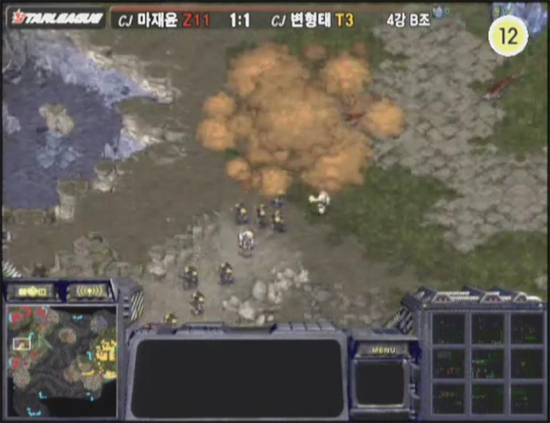
Iris catches Savior off guard
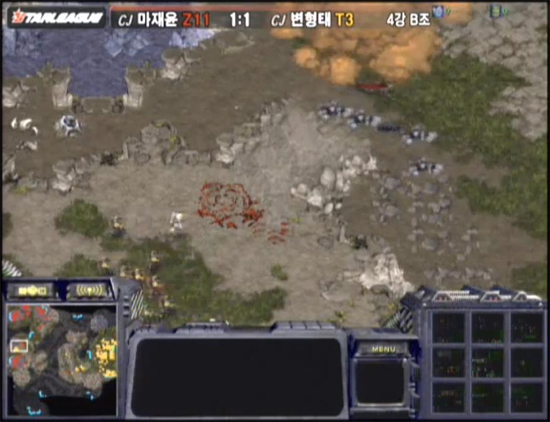
Savior desperately tries to save his expansion.
Two minutes later, Iris again successfully sneaks a potent bionic force into Savior's third.
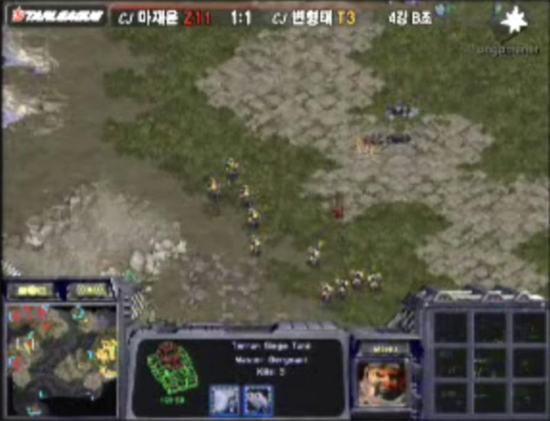
This situation once again looks great for Iris. He was able to intercept the lurkers before they blocked his path into the expansion.
Once again Iris sent a detachment to attack Savior's 3rd base and Savior attempted to block it with several lurkers. Unfortunately for Savior, his lurkers arrived just too late and Iris's army was able to get in between them and the target ramp. In this great position, Iris could kill a lurker then retreat up the ramp, thereby both preventing Savior from rescuing his expansion - Savior can't advance lurkers up a ramp against bionic holding the top without moving extremely slowly - while simultaneously having the freedom to kill drones at his leisure. This was a great situation for Iris, and he made sure to exploit it.
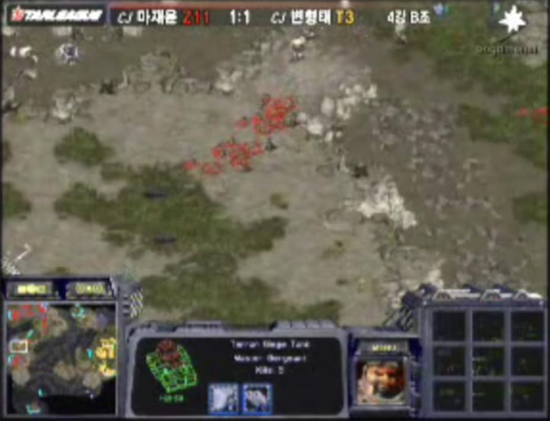
Or so he thought...
Ambushes like this are so effective because the Terran becomes so focused on the visible threat that they are completely unprepared for the real danger. Had Savior not hurried Iris into running away up the ramp, Iris would have inevitably scanned up the ramp before going up, thus escaping disaster. Only the exquisite moment of weakness that Savior presented to Iris induced Iris to waltz into a brilliantly planned trap. A foolish viewer might simply blame Iris for being 'stupid' here, but only Savior could first create then take advantage of that 'stupidity.' Iris did not have the time to scan up the ramp and suddenly run away from both lurker groups.
This exact situation developed earlier in the game and Savior had no choice but to lose units and energy to save his precious drones. Even though Iris could not hurt Savior's economy too much, Savior's frantic defense meant Iris traded units very efficiently. Thus, the fact that Savior was going to desperately charge ling-less lurkers at his enemy's second raid iteration meant that Savior had no defense ready at that moment. Therefore, Iris should charge up immediately and take advantage of that golden opportunity...
In the split second Iris had to make that decision it is completely unreasonable to expect him to do anything but what Savior made him do. Once again, because Savior was so adept at ambushing, a Terran user was punished for doing the right move.
This exact situation developed earlier in the game and Savior had no choice but to lose units and energy to save his precious drones. Even though Iris could not hurt Savior's economy too much, Savior's frantic defense meant Iris traded units very efficiently. Thus, the fact that Savior was going to desperately charge ling-less lurkers at his enemy's second raid iteration meant that Savior had no defense ready at that moment. Therefore, Iris should charge up immediately and take advantage of that golden opportunity...
In the split second Iris had to make that decision it is completely unreasonable to expect him to do anything but what Savior made him do. Once again, because Savior was so adept at ambushing, a Terran user was punished for doing the right move.

 Savior vs TheStC on Nemesis
Savior vs TheStC on NemesisIn one of his very few post-Shinhan Masters tactical displays, Savior perfectly sets up this ambush minutes in advance, showing only two deployed lurkers to TheStC initially in their middle skirmish. TheStC, preparing to attack Savior's expansion, believes that Savior is defending with only the two lurkers he saw earlier. He scouts for them with a marine, and Savior reveals the location of his lurkers above the ramp by killing the marine. Thus the TheStC sees perfectly logical and typical situation of 2 lurkers guarding the ramp of the 3rd base, and prepares to attack.
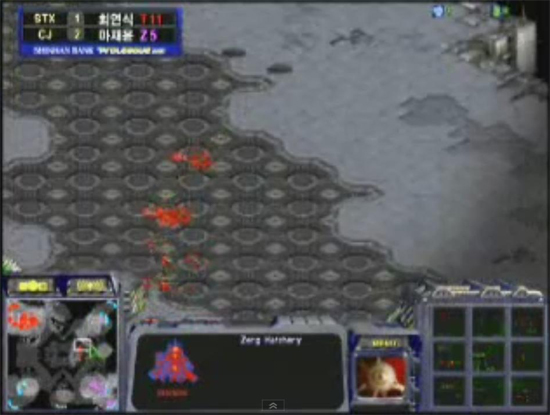
Savior skirmishes with 2 lurkers in the middle. Such a low lurker count can signify a fast hive, meaning that TheStC might have a timing to cripple Savior.
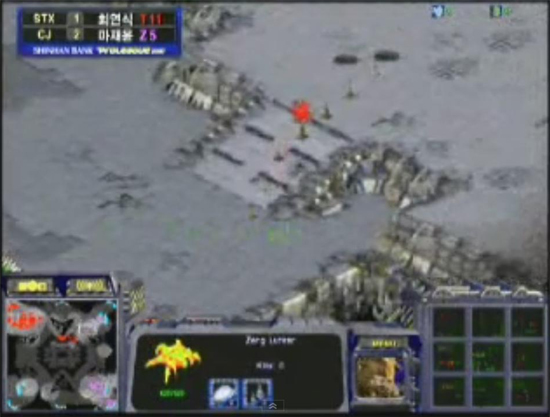
TheStC checks up the ramp and sees the same 2 lurkers shoot at his marine. If he had scanned instead, he would have only seen those 2 as well.
Notice how TheStC initially only walks a portion of his marines on top of the deadly lurker trap. Savior resists the temptation to fire on half the force, instead greedily gambling on getting the entire pack. To facilitate this end he brings over his mutalisks and uses them as a magnet. TheStC stims, trying to catch them, and naturally chases over ground he thinks is safe.
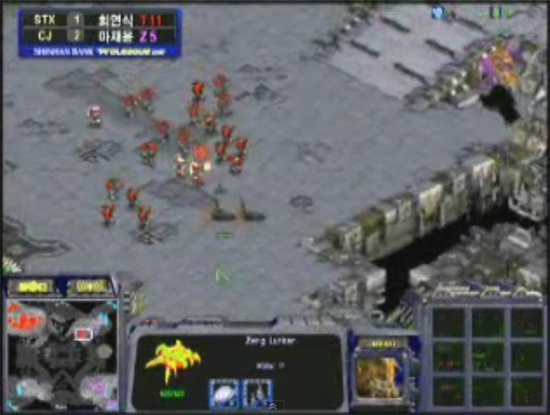
...Except, there were 4 lurkers.

A one-sided massacre results.
This type of hold lurker ambush is probably the flashiest move in Savior's arsenal. But it is just one method out of many to achieve the same objective. The crucial part of all induced ambushes is that the enemy is always shown either a consistent, logical illusion, given sufficient cause to move their units into the waiting lurkers, or preferably, both.


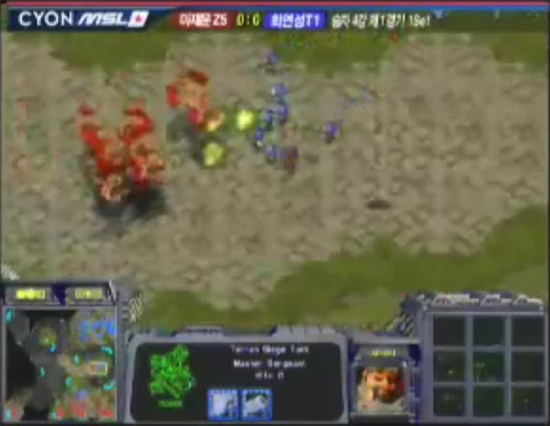
Without the lurker, Savior would win the fight but suffer excessive damage he could not afford.
Ordinarily a bio squad, even a weak one, is overjoyed to fight a horde of mutalisks in a straight up fire fight. Mutalisks simply get shredded if they aren’t properly micromanaged at all times. Thus oov felt no hesitation in stimming his reinforcements and charging forward, possibly believing he caught Savior looking elsewhere. He could not effectively run, and thus it made more sense for him to stim and attack head on than try to retreat and potentially lose marines for nothing. He simply did not fathom that a hold lurker was sitting right there, and with this hidden trump card, Savior shredded oov's now outmatched force for almost no losses in return. The muta/lurker ambush was the winning move, for oov was denied a game-changing group of reinforcements to break Savior's natural.
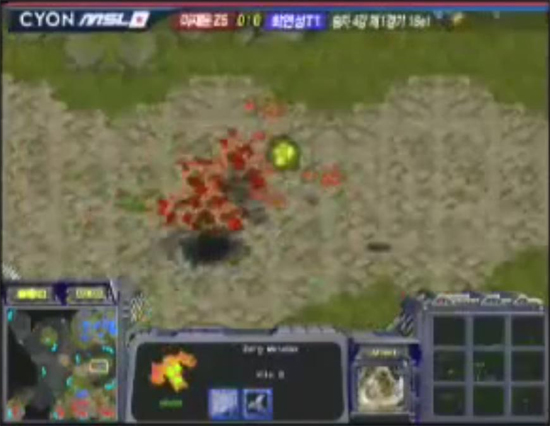
But with the lurker, the battlefield becomes a slaughterhouse.
The combination of lurkers plus another unit to hold enemies in place is vital for Savior's trap to work correctly. Leftover mutalisks from the initial mutalisk harassment are great for this purpose because they can adequately pursue any wounded infantry that try to run from the lurkers. This example also effectively illustrates how important it is for Zerg players to leave some lurkers behind the Terran army, as they can be deployed in so many useful and unpredictable ways.

 Savior vs Casy on Reverse Temple
Savior vs Casy on Reverse TempleA devastating plague is one of the most exciting actions in StarCraft. It can wreck entire armies single-handedly and has turned many games around on its own. It has also produced some of the most memorable moments in StarCraft history. However in most cases, the Terran army usually just walks away anti-climatically after being plagued. In many such situations, plague is simply a pretty ornament and useful deterrant as the Zerg just can't often pursue effectively with lurker/ling.
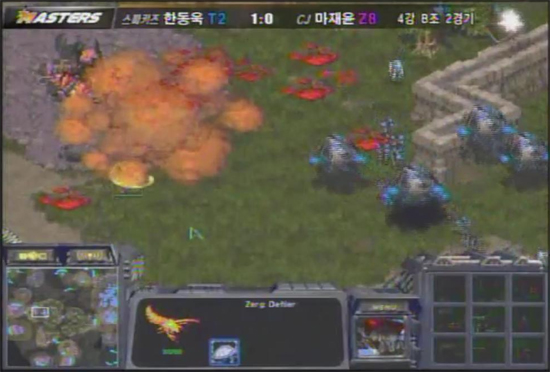
Savior consumes to get plague energy while Casy starts running.
But naturally, Savior would not limit himself to such a reward. His solution? Prepare a hidden lurker on their retreat path. Not surprisingly, blood flew. In this case, Casy even began running at the sight of Savior consuming for a plague.

Random twelve kill lurkers in the middle of nowhere are another one of Savior's trademarks.
This technique simply makes efficient use of the natural Terran reaction to plague: to retreat in the safest manner. Also note how the lurker Savior uses to ambush had been burrowed in that spot for over three minutes. Talk about planning ahead!

 Savior vs Sync on Peaks of Baekdu
Savior vs Sync on Peaks of BaekduWhen up against lurker openings, the general Terran gameplan involves frolicking around the middle, keeping the Zerg on their toes and threatening everywhere. This plan is especially valid on a map with a convoluted layout like the original Peaks of Baekdu, where the Zerg needs to split his units up in many locations. Marines and medics crush small groups of lurkers, allowing the Terran can easily put the Zerg into a position where the Zerg can easily mess up their positioning or distribution and end up behind. Roving bionic forces also can prevent drone transfers and restrict the mobility of the Zerg.
True to form, Savior attempted to turn this paradigm on its head. His game plan began with morphing hidden lurkers in the bottom right, intending to use them to keep Sync reacting to him from the start instead of vice versa. However, Sync showed great sense and spots these lurkers with an SCV, thus forcing Savior to improvise. After spotting the lurkers, Sync immediately sends a squad down to eradicate the pests. However, the lurkers manage to escape with low hp, setting in motion an important sequence of events.

The two wounded lurkers take up an assuming position. Meanwhile Sync’s search party continues northward, looking for any isolated Zerg forces. His main army simultaneously prowls the center, trying to catch any drone transfers or rallies.
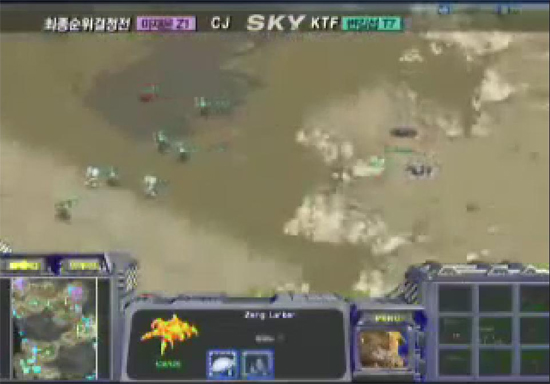
With the two lurkers in the rear still waiting, Savior blocks Sync’s path northward, narrowly missing a possible ambush.
Savior attempted to position 4 lurkers at two different spots to get some free shots off on Sync’s eastern force as it advanced northward. However Sync’s marines were just a little too quick and he spotted the lurkers in time.
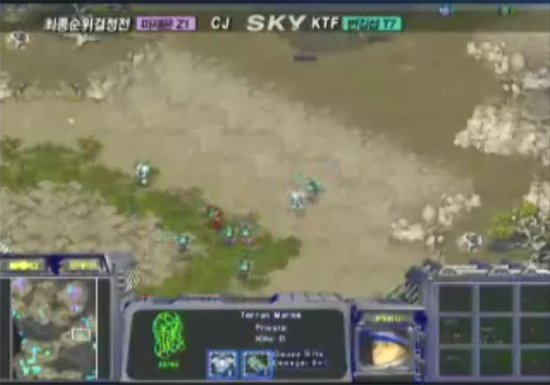
Savior’s northern lurkers begin to push back Sync’s bionic forces.
Savior actually pushes a little too quickly and Sync mercilessly picks off a lurker. Though at the same time, Sync’s force is slowly forced back close to the hidden lurkers that have waited for over a minute. Until then, Sync had walked the tightrope and had not yet fallen.
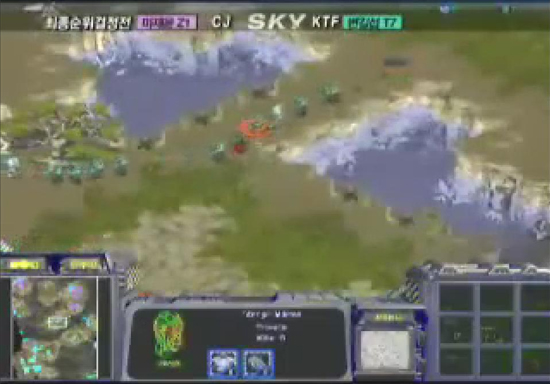
Sync’s main army walks into a lurker while he is in the process of moving his east force.
Sync’s main army originally roamed the middle and upper areas of the map trying to intercept units moving between Savior’s isolated base in the upper left and main. After Savior increasingly adopted an aggressive posture on the eastern front, Sync brought back his main army to attempt to cut off Savior’s retreat and envelop the four isolated lurkers. It was a clever attempt at thinning out Savior’s ranks, as Savior did overexpose his four advanced lurkers rather recklessly. However, all of a sudden, the game spirals out of control for Sync.
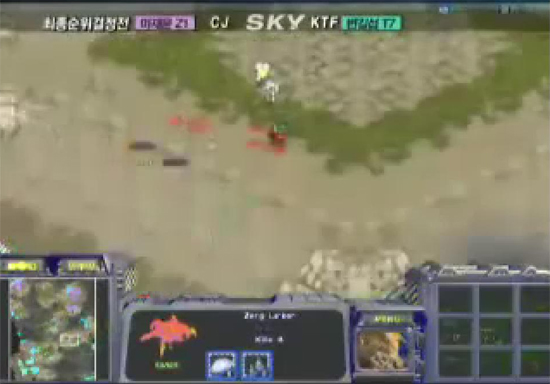
The eastern force is shredded during the chaos.
Savior had anticipated Sync’s march through the middle and positioned a lurker there to prevent access. This single lurker gave Savior the opportunity to take a huge lead. At the very moment when Sync’s main army walked across that center lurker, Savior’s eastern forces attacked Sync’s eastern platoon. Despite being busy sending his reinforcements over to join his eastern detachment, Sync reacts quickly and puts out both fires at with minimal losses at first. Unfortunately in his snap reaction he pulls his eastern army over the lurkers that have been waiting to ambush for two minutes. The main army loses two marines and his entire eastern force is decimated. Yet the action is not over just yet.
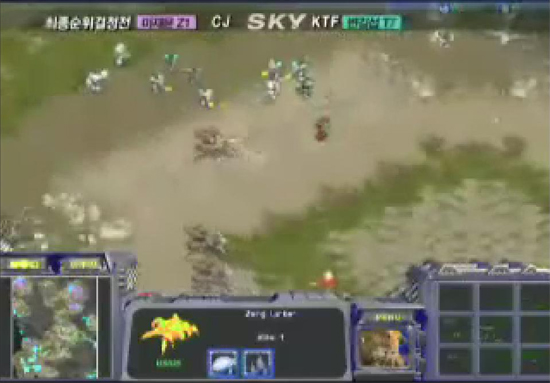
Sync attempts to prevent Savior’s eastern lurkers from joining together and kills one.
With Sync’s eastern force destroyed, Savior attempted to combine his 5 lurkers into one group to avoid being isolated and picked off. In turn, Sync quickly reacted and moves to prevent the junction. He succeeded in killing one lurker, but does not have the time to stop the remaining four from linking up. However, during the engagement, Sync’s reinforcements, over a dozen marines, ran smack into Savior’s waiting lurkers and died without firing a shot.
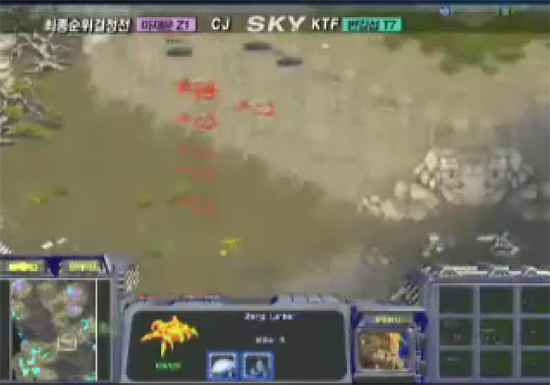
Sync’s new reinforcements are also killed in the confusion.
This was not a stupid blunder. Sync did not know about those lurkers when he originally sent the reinforcements; he simply thought they were marching on uncontested ground and could safely arrive to bolster his eastern group. In the ten seconds between his eastern detachment dying to the hidden lurkers and the death of his reinforcements, Sync was simply too busy microing and rescuing his beleaguered armies to process the newly discovered positioning of lurkers directly in the path of his reinforcements. In effect, Sync got punished for having the sharpened instinct to know that he could prevent the junction of lurkers and snipe one for free. Had he not done so, he would have been able to realize the impending suicide of his reinforcements.
Overall, this was not a perfectly masterminded ambush: Savior did not lead Sync around like a puppet. Savior simply arranged the odds the best in his favor as he could and Sync got punished for making good moves. The only aspect of this game Savior could completely control was inducing Sync’s eastern squad to retreat into the jaws of his waiting lurkers using his four northern lurkers.
As for the rest, Savior simply positioned his forces at the most optimal locations and reacted appropriately. He had no control over whether Sync brought his main army through the middle or where he sent his reinforcements. Yet by positioning the bare minimum of defenses at his natural and third, he could afford to keep an extra lurker waiting in the middle to reduce Sync’s options. In addition, Savior's two ambush lurkers served the dual purpose of being able to trap Sync’s eastern detachment as well as being able to munch on any unsuspecting reinforcements. On the whole, this series of skirmishes a great example of the value of overloading the opponent at a crucial moment.
Overall, this was not a perfectly masterminded ambush: Savior did not lead Sync around like a puppet. Savior simply arranged the odds the best in his favor as he could and Sync got punished for making good moves. The only aspect of this game Savior could completely control was inducing Sync’s eastern squad to retreat into the jaws of his waiting lurkers using his four northern lurkers.
As for the rest, Savior simply positioned his forces at the most optimal locations and reacted appropriately. He had no control over whether Sync brought his main army through the middle or where he sent his reinforcements. Yet by positioning the bare minimum of defenses at his natural and third, he could afford to keep an extra lurker waiting in the middle to reduce Sync’s options. In addition, Savior's two ambush lurkers served the dual purpose of being able to trap Sync’s eastern detachment as well as being able to munch on any unsuspecting reinforcements. On the whole, this series of skirmishes a great example of the value of overloading the opponent at a crucial moment.

 Savior vs Nada on Longinus II
Savior vs Nada on Longinus IIWhile in many of the previous cases Savior subtly induced his opponent's to run marines into lurkers, here he takes a more direct approach. NaDa sensed an opportunity to attack as Savior's defensive lurkers were still hatching. Only one sunken was in place to hold the crucial natural position. Normally, rushing forward like NaDa did would be a correct judgment. Even if Savior's lurkers would hatch and Savior reacted instantly, NaDa could do some damage and retreat safely. However, that wasn’t the complete picture.
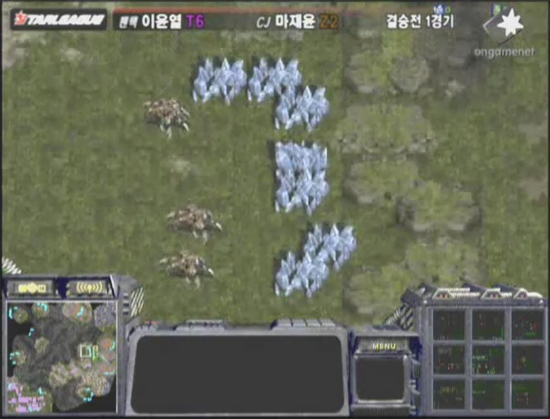
Savior preemptively hides three lurkers outside of his natural.
Once NaDa pressed ahead, instead of running to safety behind the sunken, Savior immediately burrows his under-fire lurkers, intending to force NaDa back despite suffering a casualty. NaDa correctly retreats after killing a lurker and heavily damaging another for free.
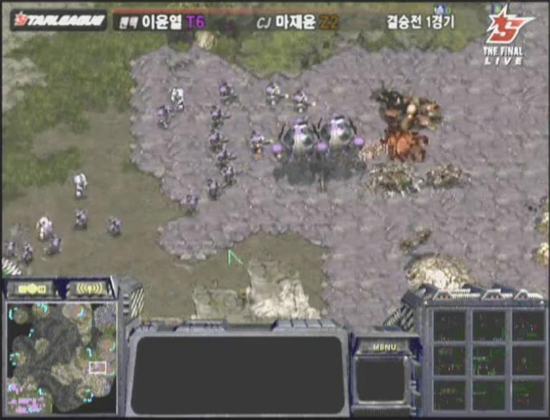
NaDa surges forward, snipes a lurker, and trots back.
Before the battle, Savior had hidden several lurkers in the fog behind NaDa's army. Once NaDa darted in, Savior burrowed these lurkers along the retreat path and called over several lings to help finish the job. The end result was that NaDa had no way to avoid the trap. He had already stimmed and would have to again, making it a battle he'd fight at half health.

NaDa retreats into lurkers he cannot avoid.
Thanks to some stellar micro, NaDa’s force is mauled, but not masticated. Savior’s zerglings were also late in arriving to the party. Had Savior gotten them there a second or two sooner and burrowed his lurkers slightly quicker, NaDa would have suffered many more losses.
Savior's hidden lurkers ran right to the position NaDa's army had just vacated when he darted forward to probe the natural. Thus NaDa ended up stuck in a situation where he absolutely had to fight burrowed lurkers head on with pure marine/medic. The most interesting part is that Savior predicted NaDa's decisions accurately. Had NaDa pressed his attack into Savior's natural, he would have suffered perhaps ten or more marine losses but would have broken Savior's defensive line and could have gotten at the drones. If NaDa went all the way with his attack, Savior would have needed to run his reinforcement lurkers up to NaDa's army from behind while they were shooting the sunken or else they would have been left out of the action entirely. Instead, Savior burrows the hidden lurkers at precisely the spot where NaDa retreats to, knowing all along that NaDa would retreat.
Savior's hidden lurkers ran right to the position NaDa's army had just vacated when he darted forward to probe the natural. Thus NaDa ended up stuck in a situation where he absolutely had to fight burrowed lurkers head on with pure marine/medic. The most interesting part is that Savior predicted NaDa's decisions accurately. Had NaDa pressed his attack into Savior's natural, he would have suffered perhaps ten or more marine losses but would have broken Savior's defensive line and could have gotten at the drones. If NaDa went all the way with his attack, Savior would have needed to run his reinforcement lurkers up to NaDa's army from behind while they were shooting the sunken or else they would have been left out of the action entirely. Instead, Savior burrows the hidden lurkers at precisely the spot where NaDa retreats to, knowing all along that NaDa would retreat.
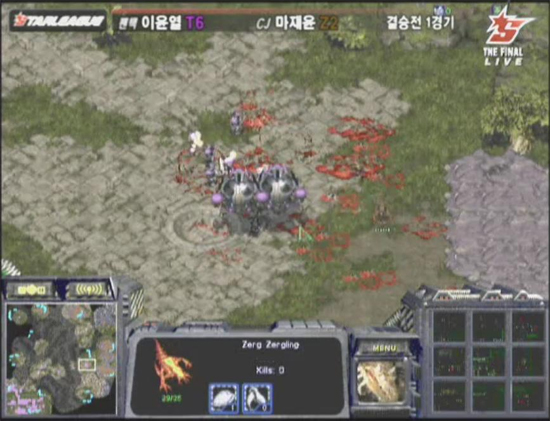
Thanks to some excellent micro by NaDa and mistiming by Savior, NaDa survives with a fraction of his units.
The entire sequence of events was a grave risk by Savior. Instead of keeping his 3 lurkers securely defending the natural, he sent them into the middle for greater flexibility in the near future and relied on a sunken and three morphing lurkers to hold. His gamble was so precisely timed that his defending lurkers hatched the exact second NaDa surged forward. Had Savior kept those three lurkers at home, NaDa could not only have just walked over to Savior's third and threatened serious damage, and Savior would have also lost the chance to cost-effectively reduce NaDa's force.
NaDa's moment of weakness was just for that single second when he left the important staging position and attacked forward, but Savior was completely ready to snatch it and maximize the amount of damage he could inflict with just a small number of units. Despite the mediocre execution by Savior, the trap still did reasonably well. With only a few units remaining, NaDa is forced to temporarily retreat, giving Savior a little more breathing room.
Furthermore, the outcome as it happened in the game was the best-case scenario for NaDa. If NaDa had looked away from his retreating army even momentarily to macro or gather reinforcements - a natural and intelligent allocation of attention given the information he knew - he would have lost everything.
NaDa's moment of weakness was just for that single second when he left the important staging position and attacked forward, but Savior was completely ready to snatch it and maximize the amount of damage he could inflict with just a small number of units. Despite the mediocre execution by Savior, the trap still did reasonably well. With only a few units remaining, NaDa is forced to temporarily retreat, giving Savior a little more breathing room.
Furthermore, the outcome as it happened in the game was the best-case scenario for NaDa. If NaDa had looked away from his retreating army even momentarily to macro or gather reinforcements - a natural and intelligent allocation of attention given the information he knew - he would have lost everything.

 Savior vs NaDa on Longinus II
Savior vs NaDa on Longinus IIHaving just barely cleared up one of NaDa's major sieges, Savior takes a serious risk. Instead of passively defending and leaving his lurkers at home to await NaDa's next assault, Savior runs all of his remaining lurkers into the middle and takes an active stance. That meant that he left one sunken, a morphing lurker, and a dozen lings to block two tanks, two vessels, and thirty infantry. However, NaDa would need to rush to take advantage of this moment of weakness, and at the moment he was in the dark.
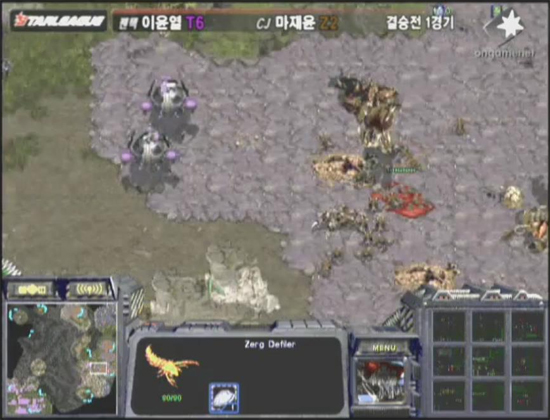
Savior leaves a paltry force at home to defend the vital natural location.
As it turns out, Savior's gamble was justified because he occupied NaDa with the threat of his maneuvering lurkers to the north, thus delaying NaDa's attack for several crucial seconds. Those seconds were all that is needed for a vital defiler to hatch. With exactly one second of leeway, NaDa scanned ahead and irradiated the defiler. Unfortunately, Savior had just enough time to get off a vital swarm. Even the small number of units Savior had under the swarm was enough to force NaDa to move away.
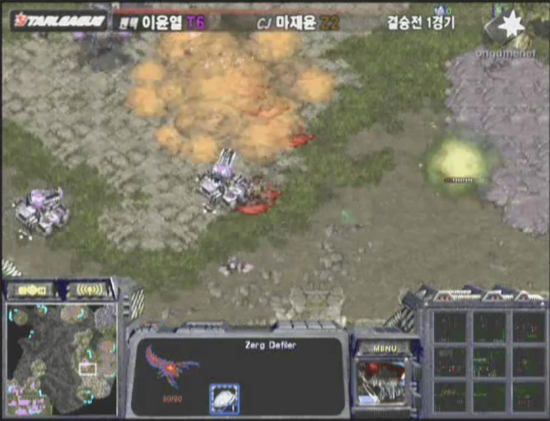
With swarm just in time, Savior pushes into the middle and forces NaDa northward.
This swarm, combined with the prior positioning of Savior’s lurkers, forces Nada to retreat northward into the jaws of his waiting lurkers. NaDa knew these lurkers were there but the swarm location and the positioning of his marines meant he had little choice in where to move.
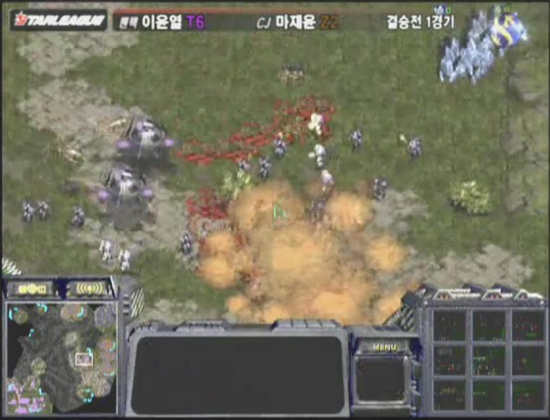
NaDa is forced to run into lurker/ling and loses a fair number of marines. To top it off, a vessel dies with NaDa powerless to save it.
Savior used scourge alongside his lurker trap in order to snipe a key vessel. NaDa tried his best to micro the vessel to safety but in the face of several lurkers, he had no way to save it. His marines were too busy fighting for their own lives to save that of the halpless vessel. This being said, Savior's timing could have been better. His trap lurkers were burrowed slightly late and NaDa's army didn't suffer quite enough casualties. As with some of the other examples, Savior’s execution was not always perfect, but the boldness of his ideas often made up for a weakness in execution. In this case the loss of the lurker/ling let him snipe the vessel, which became crucial in the upcoming minutes.

 Savior vs NaDa on Longinus II
Savior vs NaDa on Longinus IIIn a chaotic moment, NaDa senses a weakness in Savior’s position and quickly moves to exploit it. Savior is running extremely low on forces in general, and all he has in the vicinity of his targeted third base are a paltry two lurkers that just hatched and three obsolete mutalisks out of position. Fortunately, he knows two valuable pieces of information thanks to a ling trailing NaDa's force: one, NaDa's stimmed army is moving north, and two, NaDa scanned the crucial high ground position and saw nothing. From that information, NaDa intelligently pre-stimmed his marines to get up the ramp before Savior could bring over all of his units. Once NaDa got up the ramp, it was game over. Two lurkers alone simply cannot hold off two dozen bio units if they fight on open ground, even if their hp is reduced by two stims.
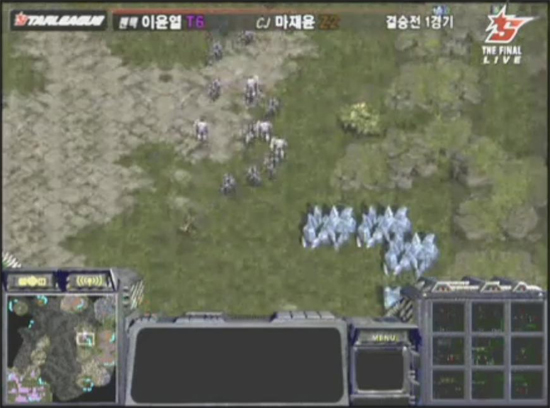
NaDa smells an opportunity and stims his marines in order to race up the hill to the third base first.
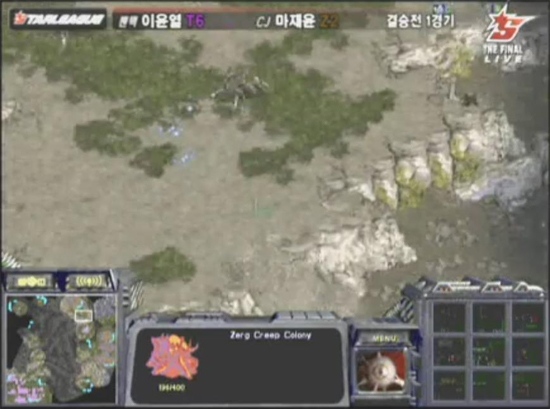
NaDa scans the crest of the hill again to confirm Savior’s weakness. The scan shows two lurkers out of position and not ready to hold.
Savior's two lurkers luckily arrived just in time and NaDa's second scan sees this. However, two lurkers that aren't fully burrowed and positioned slightly too far back cannot hold NaDa's 20 man squad. Nada again makes the intelligent decision to run up the ramp and break the position. Unfortunately for NaDa, there was another actor in the play. The instant his marines ran within lurker range three mutalisks descended from nowhere and took up an unusual role as meatshields. Instead of NaDa's marines easily clearing up the lurkers as he planned, the mutalisks tanked enough damage for the lurkers to wreck almost the entirety of NaDa's force.
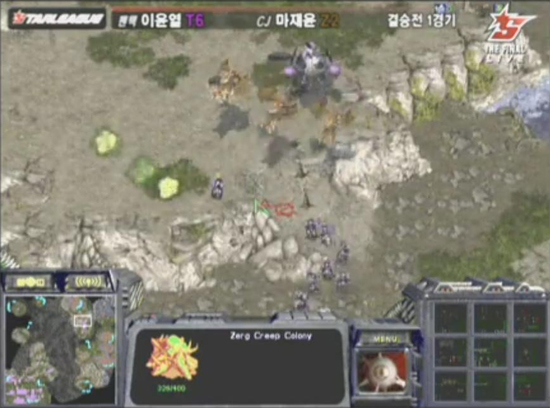
Suddenly NaDa is faced with mutalisks he never bargained for.
Rather than sending his mutalisks right alongside his lurkers for the strongest defense possible, Savior calculated that it would be smarter to bait NaDa into a rash attack. Thus Savior presented NaDa with the picture of two hurrying lurkers: a defense he could easily break. The timing on his mutalisks was completely deliberate, for he moved the mutalisks about four seconds after moving the lurkers even though he could have easily moved them any time during the last three of those seconds. What's more, the mutalisks arrived at the exact moment necessary. While the arrival of the lurkers was just scrambling happenstance, the mutalisk move was designed. NaDa's extremely skilled judgment was turned on its head.
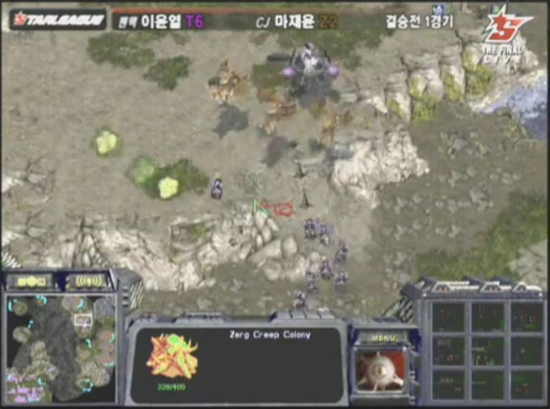
With the mutalisks to act as meatshields, the lurkers are able to shred nearly all the remaining infantry.
Let's just pause a moment and fully digest what exactly happened here. Yes, the tactic itself was great. But what's important is that Savior, in no more than a two second window, devised a creative response to chop up an entire bio squad for one lurker and three obsolete mutalisks. In such a dire situation where any other Zerg in history would be scrambling and focused on nothing more than how to avoid losing, Savior was instead thinking about how to confound his opponent and gain an advantage. While some of these tactics were clearly meticulously devised, this one was not. It's extremely unlikely Savior specifically practiced hiding away mutalisks for the specific situation where his opponent would double-stim his marines to seize a location. Yet Savior, in a moment of crisis with a dozen tasks to deal with, still had the capability to create such a well-thought out response without messing up anywhere else.
Some may criticize NaDa here but what was he supposed to do, not take an opportunity that presented itself with the utmost skill and vigor? If those mutalisks hadn't arrived at that very moment, NaDa would have been able to cripple or raze the expansion and gain a decisive edge. In that scenario, he would be praised for his killer instinct. NaDa did all that could be asked of him, but ultimately that was just not enough.
Some may criticize NaDa here but what was he supposed to do, not take an opportunity that presented itself with the utmost skill and vigor? If those mutalisks hadn't arrived at that very moment, NaDa would have been able to cripple or raze the expansion and gain a decisive edge. In that scenario, he would be praised for his killer instinct. NaDa did all that could be asked of him, but ultimately that was just not enough.
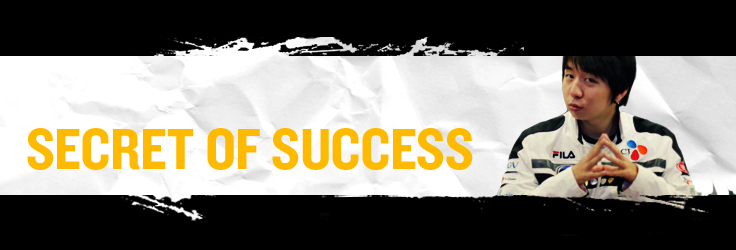
How did Savior do it? How did he come to intuitively understand game flow at such an unparalleled level? How did he create an entire tactical system using unique psychological approaches from scratch?
It would be easy to answer this question by simply by saying Savior was naturally brilliant. However, this is unsatisfactory. The methodology for any specialist is often just as important as his latent abilities. In this case, the rather unique answer is that Savior was so good versus Terran users because he specifically practiced as Terran!
It would be easy to answer this question by simply by saying Savior was naturally brilliant. However, this is unsatisfactory. The methodology for any specialist is often just as important as his latent abilities. In this case, the rather unique answer is that Savior was so good versus Terran users because he specifically practiced as Terran!
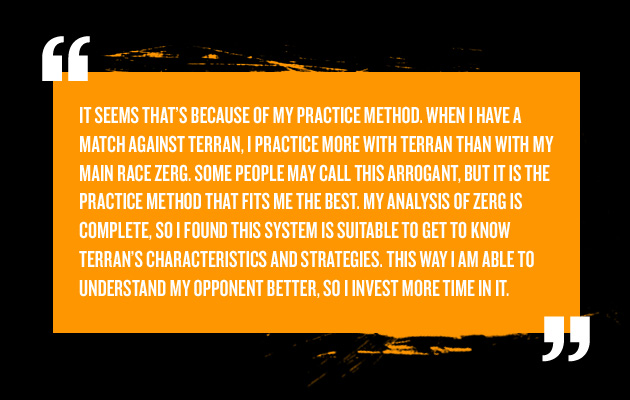
There is a direct relationship between when Savior adopted his new practice method and his increased ZvT understanding. Once Savior's schedule become burdensome in late 2006 and early 2007, he began to practice from his opponent's perspective. It is no coincidence that his tactical abilities sharply improved during this period as well.

In other words, once Savior reached the highest level he could by studying it only from his own point of view, he began to look at it from his opponent's perspective. By doing so, he was able to really get inside his opponent's subconscious, and thus devise schemes to take advantage of this knowledge. Many times in these articles I have explained how Savior punished the correct Terran responses; his practice method is entirely the reason behind his ability to do so. Savior's story is an extremely valuable lesson to his peers, as well as a different learning approach for those stuck at a certain level.
It could also be said that Savior only reached the peak of Zerg after he started playing as Terran more than Zerg. As odd and counter-intuitive as that statement may sound, it also makes considerable sense upon reflection. Why has no Zerg managed to replicate anything remotely resembling Savior's tactical capability, despite the full blueprint already have been laid out for them? Perhaps it is just because they have not spent enough time practicing as Terran against Zerg.
This practice method also explains Savior's unique strengths and weaknesses. In many ways he was an anomaly: one of the greatest champions, yet very mechanically mediocre. While other progamers spent countless hours sharpening their mechanics with their main race, Savior instead honed his intuition and game sense from another angle. He was the only champion utterly incapable of going all-in, yet one of the most invincible in the late game. Alongside players like iloveoov and Nal_ra, Savior's very existence runs counter to claims of Brood War being a game of mechanics over strategy.
However, just describing Savior as smart is not discerning enough. Intelligence in Brood War can manifest itself in many ways. For example, iloveoov and Flash are also extremely clever players whose major strengths consist of strategy, decision-making, and game sense alongside comparatively weaker mechanics. Compared to them, one cannot argue that Savior was smarter; instead, he was simply unique.
No other progamer can boast of his ability to intimately feel the flow of the game and alter it at will. When fans reminisce about watching Savior in his prime, they often invoke feelings of magic or wonder about his play. This may sound like a bunch of nostalgic, mystical hocus-pocus; after all, it is an extremely subjective judgment. Yet it is not said without reason. Before Savior, players like NaDa and iloveoov had objectively accomplished more by any measuring stick. However, it was Savior, not them, who so impressed the fans that they felt the need to create the bonjwa line. For Savior, there somehow always seemed space for something special, something solid, something stable. He saw that the spectacular, the stunning, and the striking are rooted in simple, subtle movements.
It could also be said that Savior only reached the peak of Zerg after he started playing as Terran more than Zerg. As odd and counter-intuitive as that statement may sound, it also makes considerable sense upon reflection. Why has no Zerg managed to replicate anything remotely resembling Savior's tactical capability, despite the full blueprint already have been laid out for them? Perhaps it is just because they have not spent enough time practicing as Terran against Zerg.
This practice method also explains Savior's unique strengths and weaknesses. In many ways he was an anomaly: one of the greatest champions, yet very mechanically mediocre. While other progamers spent countless hours sharpening their mechanics with their main race, Savior instead honed his intuition and game sense from another angle. He was the only champion utterly incapable of going all-in, yet one of the most invincible in the late game. Alongside players like iloveoov and Nal_ra, Savior's very existence runs counter to claims of Brood War being a game of mechanics over strategy.
However, just describing Savior as smart is not discerning enough. Intelligence in Brood War can manifest itself in many ways. For example, iloveoov and Flash are also extremely clever players whose major strengths consist of strategy, decision-making, and game sense alongside comparatively weaker mechanics. Compared to them, one cannot argue that Savior was smarter; instead, he was simply unique.
No other progamer can boast of his ability to intimately feel the flow of the game and alter it at will. When fans reminisce about watching Savior in his prime, they often invoke feelings of magic or wonder about his play. This may sound like a bunch of nostalgic, mystical hocus-pocus; after all, it is an extremely subjective judgment. Yet it is not said without reason. Before Savior, players like NaDa and iloveoov had objectively accomplished more by any measuring stick. However, it was Savior, not them, who so impressed the fans that they felt the need to create the bonjwa line. For Savior, there somehow always seemed space for something special, something solid, something stable. He saw that the spectacular, the stunning, and the striking are rooted in simple, subtle movements.

Other Work by Ver
Lings of Liberty: The Rise of the PatchZergs
God of the Battlefield: Part 1
iloveoov: The Greatest Genius
How to Improve
Follow Ver on Twitter.
Lings of Liberty: The Rise of the PatchZergs
God of the Battlefield: Part 1
iloveoov: The Greatest Genius
How to Improve
Follow Ver on Twitter.



